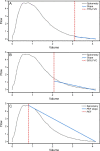Comparison of New Spirometry Measures to Diagnose COPD
- PMID: 36414276
- PMCID: PMC10027157
- DOI: 10.4187/respcare.10191
Comparison of New Spirometry Measures to Diagnose COPD
Abstract
Background: COPD is diagnosed by using FEV1/FVC, which has limitations as a diagnostic test. We assessed the validity of several measures derived from the expiratory phase of the flow-volume curve obtained from spirometry to diagnose COPD: the slopes that correspond to the volume expired after the 50% and 75% of the FVC, the slope formed between the peak expiratory flow (PEF) and the FVC, and the area under the expiratory flow/volume curve.
Methods: We conducted a cross-sectional diagnostic test study in 765 consecutive subjects referred for spirometry because of respiratory symptoms. We compared the reproducibility and accuracy of the proposed measures against post-bronchodilator FEV1/FVC < 0.70. We also evaluated the proportion of respiratory symptoms for the FEV1/FVC, FEV1 per FEV in the first 6 s (FEV6), and the PEF slope.
Results: The subjects had a mean age of 65.8 y, 57% were women, and 35% had COPD. The test-retest intraclass correlation coefficient values were 0.89, 0.85, and 0.83 for FEV1/FVC, FEV1/FEV6, and the PEF slope, respectively. The area under the curve values were 0.93 (expiratory flow/volume), 0.96 (potential expiratory flow/volume), 0.97 (potential expiratory flow/volume at 75% of FVC), and 0.82 (potential expiratory flow/volume at 50% of FVC). The area under the receiver operating characteristic curve was 0.99 for FEV1/FEV6, 0.99 for the slope at 50% of the FVC, and 0.98 for the PEF slope.
Conclusions: The FEV1/FEV6, PEF slope, and 50% FVC slopes had similar diagnostic performances compared with FEV1/FVC.
Keywords: ROC curve; chronic obstructive; early diagnosis; pulmonary disease; spirometry.
Copyright © 2023 by Daedalus Enterprises.
Conflict of interest statement
The authors have disclosed no conflicts of interest.
Figures



References
-
- Halpin DMG, Criner GJ, Papi A, Singh D, Anzueto A, Martinez FJ, et al. . Global Initiative for the Diagnosis, Management, and Prevention of Chronic Obstructive Lung Disease. The 2020 GOLD Science Committee Report on COVID-19 and Chronic Obstructive Pulmonary Disease. Am J Respir Crit Care Med 2021;203(1):24-36. - PMC - PubMed
-
- Menezes AMB, Pérez-Padilla R, Jardim JRB, Muiño A, López V, Valdivia G, et al. ; PLATINO Team. Chronic obstructive pulmonary disease in five Latin American cities (the PLATINO study): a prevalence study. Lancet 2005;366(9500):1875-1881. - PubMed
-
- Caballero A, Torres-Duque CA, Jaramillo C, Bolívar F, Sanabria F, Osorio P, et al. . Prevalence of COPD in five Colombian cities situated at low, medium, and high altitude (PREPOCOL Study). Chest 2008;133(2):343-349. - PubMed
-
- López-Campos JL, Tan W, Soriano JB. Global burden of COPD. Respirology 2016;21(1):14-23. - PubMed
-
- Labaki WW, Rosenberg SR. Chronic obstructive pulmonary disease. Ann Intern Med 2020;173(3):ITC17-ITC32. - PubMed
MeSH terms
LinkOut - more resources
Full Text Sources
Medical

